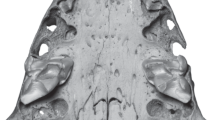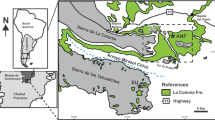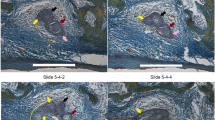Abstract
We investigated the state of dental eruption in specimens of Macroscelides proboscideus and Erinaceus europaeus of known age. When M. proboscideus reaches adult size and sexual maturity, few or none of its replaced permanent cheek teeth have erupted. The approximate sequence of upper tooth eruption is P1, [I3, C, M1], [I1–2], M2, P4, [P2, P3]. Chronologically, E. europaeus erupts its molars and most premolars prior to M. proboscideus; but its first two upper incisors erupt after those of M. proboscideus, and its canines erupt around the same time. The approximate sequence of upper tooth eruption in E. europaeus is [M1, M2, P2, I3], C, M3, P4, P3, I2, I1. Unlike M. proboscideus, E. europaeus does not reach adult size until all permanent teeth except for the anterior incisors have erupted. While not unique among mammals, the attainment of adult body size prior to complete eruption of the permanent cheek teeth is particularly common among macroscelidids and other afrotherians.



Similar content being viewed by others
References
Anderson A, Wallmo O (1984) Odocoileus hemionus. Mammal Species 219:1–9 doi:10.2307/3504024
Asher RJ (2005) Insectivoran grade placental mammals: character evolution and fossil history. In: Rose KD, Archibald D (eds) The Rise of Placental Mammals: Origin and Relationships of the Major Clades. Johns Hopkins University Press, Baltimore, pp 50–70
Asher RJ, Lehmann T (2008) Dental eruption in afrotherian mammals. BMC Biol 6:14 doi:10.1186/1741-7007-6-14
Beatty B (2008) Craniodental ontogeny in the Desmostylia. J Vertebr Paleontol 283:49A
Bronner G (1992) Notes on the early postnatal development of a giant golden mole. Koedoe 35:57–58
Corbet GB, Hanks J (1968) A revision of the elephant-shrews, Family Macroscelididae. Bull Brit Mus Nat Hist Zool 16:47–111
de Magalhaes JP, Costa J, Toussaint O (2005) HAGR: the Human Ageing Genomic Resources. Nucleic Acids Res 33:D537–D543 doi:10.1093/nar/gki017
Domning DP, Hayek L (1984) Horizontal tooth replacement in the Amazonian Manatee (Trichechus inunguis). Mammalia 48:105–127
Douady CJ, Catzeflis F, Raman J, Springer MS, Stanhope MJ (2003) The Sahara as a vicariant agent, and the role of Miocene climatic events, in the diversification of the mammalian order Macroscelidea (elephant shrews). Proc Natl Acad Sci USA 10014:8325 doi:10.1073/pnas.0832467100
Eisenberg JF, Gould E (1970) The tenrecs: a study in mammalian behavior and evolution. Smithson Contrib Zool 27:1–138
Evans FG (1942) The osteology and relationships of the elephant shrews (Macroscelididae). Bull Am Mus Nat Hist 80:85–125
Holroyd P (2008) New data on dental eruption patterns in condylarths and afrotheres. J Vertebr Paleontol 283:93A
Jennings MR, Rathbun GB (2001) Petrodromus tetradactylus. Mammal Species 682:1–6 doi:10.1644/1545-1410(2001)682<0001:PT>2.0.CO;2
Kellas L (1954) Observations on the reproductive activity, measurement and growth-rate of the dik-dik. Proc Zool Soc Lond 124:751–784
Kindahl M (1958) Some observations on the development of the tooth in ElephantuIus myurus jamesoni. Arkiv zool 11:21–29
Kindahl M (1959) The tooth development in Erinaceus europaeus. Acta Odontol Scand 17:468–489
Koontz FW, Reeper NJ (1983) Elephantulus rufescens. Mammal Species 204:1–5 doi:10.2307/3503972
Laws R (1966) Age criteria for the African elephant, Loxodonta africana. Afr Wildl J 4:1–37
Laws R (1968) Dentition and ageing in the hippopotamus. Afr Wildl J 6:19–52
Leche W (1907) Zur Entwicklungsgeschichte des Zahnsystems der Säugetiere, zugleich ein Beitrag zur Stammengeschichte dieser Tiergruppe. Zoologica Stuttg 49:1–157
Loe LE, Meisingset EL, Mysterud A, Langvatn R, Stenseth NC (2004) Phenotypic and environmental correlates of tooth eruption in red deer (Cervus elaphus). J Zool (Lond) 262:83–89 doi:10.1017/S0952836903004436
MacPhee RDE (1987) The shrew tenrecs of Madagascar: systematic revision and Holocene distribution of Microgale (Tenrecidae, Insectivora). Am Mus Novit 2889:1–45
Morris PA (1970) A method for determining absolute age in the hedgehog. J Zool (Lond) 161:277–281
Morris PA (1971) Epiphyseal fusion in the forefoot as a means of age determination in the hedgehog (Erinaceus europaeus). J Zool (Lond) 164:254–259
Morris PA (1978) The use of teeth for estimating the age of wild mammals. In: Butler PM, Joysey KA (eds) Development, Function and Evolution of Teeth. Academic, London, pp 483–494
Olbricht G (2009) Aspects of the reproductive biology of sengis (Macroscelidea) in general and post-natal development of the short-eared sengi (Macroscelides proboscideus) in particular. PhD dissertation, Univ Duisburg-Essen
Olbricht G, Kern C, Vakhruscheva G (2006) Einige Aspekte der Fortpflanzungsbiologie von Kurzohr-Ruesselspringern. Zool Gart 5–6:304–316
Rathbun G (1979) The social structure and ecology of elephant-shrews. Fortschr Verhaltensforsch 20:1–76
Rees J, Kainer R, Davis R (1966) Chronology of mineralization and eruption of mandibular teeth in mule deer. J Wildl Manage 30:629–631 doi:10.2307/3798761
Reeve N (1994) Hedgehogs. Cambridge University Press, Cambridge
Robinette W, Jones D, Rogers G, Gashwiler J (1957) Notes of tooth development and wear for Rocky Mountain mule deer. J Wildl Manage 21:134–153 doi:10.2307/3797579
Roche J (1978) Denture et age des Damans de rochers (genre Procavia). Mammalia 42:97–103
Rosenthal M (1975) The management, behavior and reproduction of the short-eared elephant shrew Macroscelides proboscideus (Shaw). Masters Thesis, Northern Illinois University
Sauer EM (1973) Zum Socialverhalten der Kurzohrigen Elefantenspitzmaus. Z Saugetierkd 38:65–97
Sauer FG, Sauer EM (1972) Zur Biologie der Kurzohrigen Elefantenspitzmaus. (M. proboscideus). Z Kolner Zoo 15:119–139
Schoeman S, Bennett N, van der Merwe M, Schoeman A (2004) Aseasonal reproduction in the Hottentot golden mole, Amblysomus hottentotus (Afrosoricida: Chrysochloridae) from KwaZulu-Natal, South Africa. Afr Zool 39:41–46
Smith BH (1989) Dental development as a measure of life history in primates. Evolution 43:683–688 doi:10.2307/2409073
Smith BH (2000) “Schultz’s Rule” and the evolution of tooth replacement patterns in primates and ungulates. In: Teaford MF, Smith MM, Ferguson MWJ (eds) Development, Function and Evolution of Teeth. Cambridge University Press, Cambridge pp 212–227
Springer MS, Stanhope MJ, Madsen O, de Jong WW (2004) Molecules consolidate the placental mammal tree. Trends Ecol Evol 19:430–438 doi:10.1016/j.tree.2004.05.006
Tabuce R, Asher RJ, Lehmann T (2008) Afrotherian mammals: a review of current data. Mammalia 72:2–14 doi:10.1515/MAMM.2008.004
van Nievelt A, Smith KK (2005) To replace or not to replace: the significance of reduced tooth replacement in marsupial and placental mammals. Paleobiol 31:324–346 doi:10.1666/0094-8373(2005)031[0324:TRONTR]2.0.CO;2
Acknowledgments
We thank U. Schürer, A. Sliwa, and the staff of the Wuppertal Zoo for access to specimens and data files of M. proboscideus. We also thank P.A. Morris for access to his E. europaeus collection and comments on assignment of ages in that taxon; L. Tomsett for access to the NHM London; C. Denys and J. Cuisin for access to the MNHN Paris; O. Grönwall, P. Eriksson, and the European Commission’s Research Infrastructure Action via the SYNTHESYS Project (SE-TAF 4069) for access to the NRM Stockholm; F. Mayer and H. Turni for access to the Museum für Naturkunde Berlin; A. Heaver, A. Goswami, and S. Sawiak for access to noninvasive imaging facilities in the departments of Engineering, Earth Sciences, and the Wolfson Brain Imaging Centre (respectively) at the University of Cambridge. We are grateful to T. Lehmann for data on ZMB specimens, and to T. Lehmann, A. Evans, and G. Rathbun for comments on the manuscript.
Author information
Authors and Affiliations
Corresponding author
Appendix
Appendix
Raw data on state of eruption and jaw length. “Erupt/10” indicates the number of completely erupted permanent cheek teeth with interlocking occlusion, taken as a proportion out of ten (indicating presence of all normally erupted cheek teeth). In cases where the dentition was incomplete (e.g., dentary lost), the proportion was calculated out of the maximum possible number of interlocking permanent cheek teeth for that specimen and species. “Symph-cond” indicates the distance in mm from the anterior margin of the mandibular symphysis to the posterior margin of the mandibular condyle (Asher and Lehmann 2008: fig. 1). “Prop adult jaw” indicates a given specimen’s symphysis-condyle length divided by the median length obtained for all specimens of that species with the permanent cheek teeth completely erupted (i.e., with a “erupt/10” value of ten), as indicated in the column “median jaw”. Institutional abbreviations are as follows: BMNH = Natural History Museum London; MNHN = Museum National d’Histoire Naturelle Paris; NRM = Naturhistoriska Riksmuseet Stockholm (previously abbreviated as “RS” in Asher and Lehmann 2008); TM = Transvaal Museum Pretoria; UMZC = University Museum of Zoology Cambridge; w = Wuppertal sengi colony described in Olbricht (2009), housed at the UMZC; ZMB = Zoologisches Museum Berlin.
Rights and permissions
About this article
Cite this article
Asher, R.J., Olbricht, G. Dental Ontogeny in Macroscelides proboscideus (Afrotheria) and Erinaceus europaeus (Lipotyphla). J Mammal Evol 16, 99–115 (2009). https://doi.org/10.1007/s10914-009-9105-2
Received:
Accepted:
Published:
Issue Date:
DOI: https://doi.org/10.1007/s10914-009-9105-2




